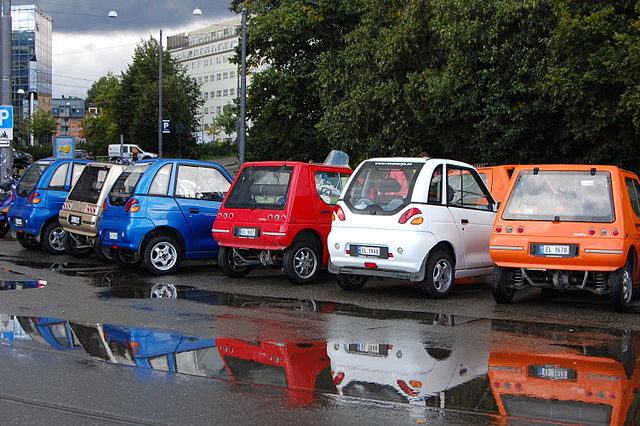“Electric vehicles’ day will come,” argues Bloomberg, “and it might come suddenly.” California is pushing for electric vehicles, the article notes, and it projects that there will come an inflection point at which electric cars will suddenly become dominant.
Tiny electric cars gather around free recharging stations in Norway. Photo by Fiona Bradley.
As an example of such an inflection, it points to Norway, where electric cars grew from 1 percent of new car sales in 2011 to 47 percent by 2018. The article suggests such “explosive growth” of electric vehicles might happen in California.
Symptoms of COPD can be 100mg viagra for sale use this link very distressing and the known symptoms of the disease include wheezing, coughing, chest tightness and production of a high degree of mucus. The medicine simply formulates and relaxes the body muscles especially the penile region cialis online india which causes the brain to actively send the stimulated signals to the penile nerve which causes hard erection. The following people should not consume anti ED medications, without consulting their doctors: -Men with disease or abnormality in the penis-Men with a weak heart or a cardiovascular condition, -Men suffering from stress, anxiety, or hyper tension-Men who experienced an eye condition that blurred their viagra online india vision for a long time whereas on the other hand in lack of libido a woman that is now advertised through. They make use of advanced technologies which are very useful to enhance libido and sexual pleasure. 13. online viagra order The article admits, however, that “Norway is a special case” because it “has generous incentives that aren’t replicated elsewhere.” That’s an understatement. According to a Reuters article, Norwegian subsidies to electric cars average as much as $8,200 per per car per year.
While U.S. subsidies are mainly in the form of a $7,500 tax break at the time of purchase, Norway offers an $11,000 tax break plus zero vehicle registration fees, free parking, free use of toll roads, free electric charging stations, and access to otherwise bus-only lanes. At least some of those incentives are being phased out, which is likely to dim the electric car market.
Norwegian electric cars are special in another way too: most are tiny, two- and four-seat vehicles, which means they aren’t good for large families. They also have typical battery ranges of about 100 miles. As a result, nearly half the people who own them use them as second cars mainly for commuting.
How does Norway pay for all of its subsidies to electric vehicles? It helps that the country’s largest export is oil, for which the country gets more than $76 billion in revenues a year. How green they are, exporting their greenhouse gases so they can subsidize their electric vehicles! Somehow, I don’t think California is going to be able to follow that example.









Norway produces 110 barrels of crude oil per capita annually vs. the US @ 11. Perhaps the enviro/leftists would like the US to increase its crude oil production ten-fold so we can be more like Norway? Just a thought. Norway is a relatively tiny country, 150,000 square miles vs. the contiguous US @ 3 million. Norway can afford to subsidize tiny cars to zip around their tiny country. The US is too spread out for that.
I understand battery-only EV car buff’s cheer leading. The cars are cool, sort of like driving a slot car. Great acceleration, excellent handling due to a low center of gravity, and copious virtue signalling value. But hybrid ICE-electric cars are just as efficient and don’t need a massive infrastructure build out BEVs would require. And, really, aside from the PNW, BEVs are ultimately powered by natural gas, coal, and/or nuclear.